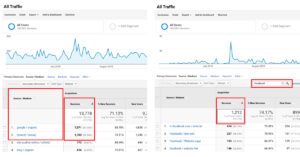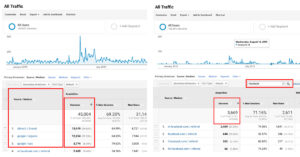Greased Liking: Facebook Speeds Forward in Quality Traffic Referrals

Sometimes a cigar is just a cigar. But, then again, sometimes it’s not. In the case of website traffic you not only want a sizable number of visitors to peek at your medical or dental site, you also want those prospective patients to rummage through your content long enough to learn about you and your practice. So, is Google still the best medium for securing an attentive audience? Depends not on who, but when you ask. The answer will vary from moment to moment and month to month. Although the Big G still maintains a firm foothold, three sources are generally vying for the lead: Google, direct access (people going straight to your site, no middleman), and Facebook.
Google has long reigned as King Referrer (where most organic traffic comes from), but the Silicon Giant’s grip on the throne has been inconsistent for at least the last year. Facebook has occasionally (no doubt gleefully) wielded the scepter, and as a traffic source for news, it is beyond question that the ‘book has replaced the once all-powerful ruler. But does that mean you should focus all or even most of your media marketing efforts on Facebook—or any single traffic referrer?

While selective healthcare procedures are sometimes found in the news, that’s an ill-fitting category for your practice website. As Lea, our strategist for all things social media, points out, “For targeting the right audience, FB is still número uno. However, Facebook has fallen off in their organic reach.” In English, one cannot rely on a single source of traffic alone. Like a good investor, you should diversify your marketing portfolio.
Let’s take a look at some examples. Below we have a performance analysis for one of our clients, a plastic surgeon:

If you look at the Source/Medium column, you can see that traffic emanating from Google accounted for a bit over 51% of the sessions. Direct access traffic accounted for a hair over 12%, and Facebook had almost 9%. (Other sources also contribute a small amount, which is why these numbers don’t add up to 100%.)
Here’s another diagnostics example, from a dental marketing client:

In this example, Facebook pulls in over 8% of traffic. Direct access accounts for nearly 30% of traffic and Google almost 27%. Now 8% may not sound impressive at first, but these are quality visitors. The bounce rate from this source is low, and these guests visit as many pages as do the ones from Google, and they stay just as long—which is exactly what you want.
The important takeaway from all of this is that Facebook is an increasingly influential source of traffic. Says Lea, “Facebook is quickly joining ranks with Google and direct traffic as a top referrer.” As the social media supersite continues to divert eyeballs from everything on and off the Internet, you can bet that incorporating it as part (not all!) of your approach to marketing can help ensure a substantial crowd continues to shuffle through your digital doors.
To learn more about how integrated marketing can help your practice, talk to our knowledgeable team today.